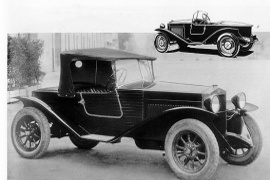FIAT 509 S Models/Series Timeline, Specifications & Photos
First production year: 1925
Engines: Gasoline
Body style: Convertible (spider/spyder, cabrio/cabriolet, drop/open/soft top)
When Fiat made the 509 A for the masses, it also created a faster version for those looking for a sportier but still affordable vehicle, sort of a hot-hatch of the ‘20s.
The Italian automaker was already reckoned for its sporty vehicles. In addition, its engineering department was very efficient and developed a 12-volt electrical system for the 509. But then, Fiat’s board knew that the best advertising at those times was through motorsports, so it created the 509 S. Even though that version relied on the same chassis and other underpinnings of its 509 A sibling, it was improved to provide better acceleration times and a higher speed. And, despite all those improvements, it was still similarly priced as the non-S version.
In a time when most automakers delivered their products as rolling chassis to customers, who had to complete them at coachbuilders, Fiat chose to make the bodywork in-house to lower the price of the finished vehicle. As a result, the 509 S sported the same front fascia as the 509 A. It featured a flat radiator at the front surrounded by a brass trim and a V-shaped top. The arched front fenders supported the electric headlights, which were still new to the market. Lower, under the chassis, the automaker installed the semi-elliptic leaf springs that peaked in front of the car.
From its profile, the 509 S distinguished itself with a specific two-door and open-top bodywork. Fiat installed a flat, vertical windshield and added a pair of electric wipers at the top. The canvas roof could be retracted behind the small cabin that accommodated just two passengers. Since the car’s wheelbase was short, the automaker couldn’t place the spare wheels on the sides next to the engine compartment. As a result, it placed them out back, behind the trunk. While this was not the best solution for those times since it obstructed access to the trunk, it still worked for most occasions.
The car’s simple interior featured a flat dash panel where Fiat installed several dials and gauges in the center and in front of the side passenger. At the same time, the driver fronted just the large four-spoke steering wheel. Since the car featured an open-top bodywork, the automaker installed leather upholstery for the seats and the door cards. The rag top was not the most aerodynamically correct solution. Still, at least it could protect the 509 S’s occupants against elements from above. As an option, customers could opt for removable side windows.
Since the 509 S was based on the same chassis as the successful 509 A, it was fitted with four-wheel drum brakes, which was innovative. Furthermore, the front rigid axle and the live rear axle ensured the car had adequate handling for those times. Under the hood, Fiat installed a one-liter single-overhead camshaft engine fed by an improved carburetor version mounted on the 509 A. As a result, it produced five more ponies than that.
